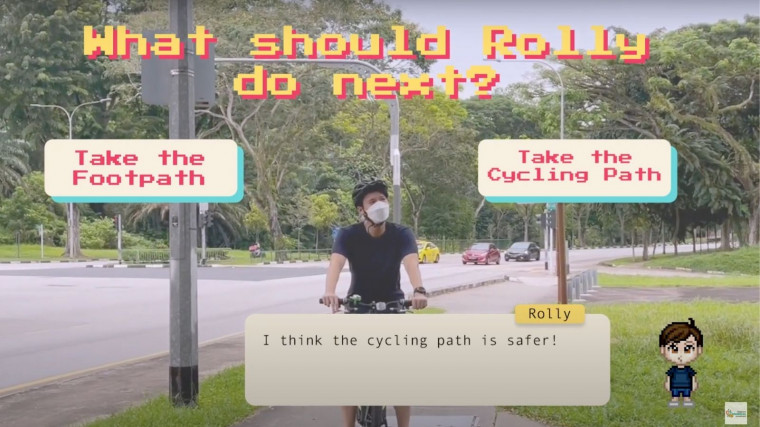|
Audio Version Available
|
Cycling has become a more popular pastime here over the past two years, as Singaporeans are unable to travel overseas search for more outdoor activities. Add the growing number of food delivery riders and our paths are looking more and more crowded.
However, with more users on shared paths come more disputes. In a recent poll, more than 80 per cent of respondents felt there are more errant cyclists today on both roads and pavements. And a majority (more than 90 per cent) believed that there should be more rules applied to cycling and cyclists.
By 2030, Singapore’s cycling path network will expand to more than 1,300 km.
In land-scarce Singapore, this means that cyclists and pedestrians would have to learn to co-exist on shared paths.
Tensions between pedestrians and cyclists
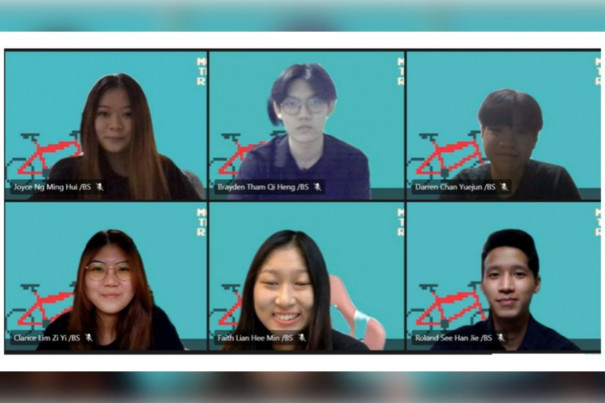
That was the challenge faced by two student groups from Ngee Ann Polytechnic, who came up with social media campaigns focused on path-sharing as part of their final-year projects.
When the teams started their projects with some informal polling from their friends and acquaintances, they found that there was indeed tension between those who share the paths.
Recounts Brayden Tham, 19: “There was a heated debate going on between pedestrians and PMD users. Each of them had their own point of view: PMD users called out pedestrians for not sticking to the left or paying attention on the path, and pedestrians called out PMD users for speeding and taking up the whole road.”
Brayden is part of the six-student team who came up with More Than Ride.
He tells The Pride: “We heard feedback like ‘they (pedestrians who hog shared paths) deserve to get in an accident’ or ‘some cyclists (who ride on shared paths) take up the whole space, they think they own the road… ’”
The students found that there were several issues that hampered good path sharing habits, such as a misconceived sense of self-entitlement when it comes to giving way and the lack of safety habits among both parties.
That is why both teams focused on growing empathy and understanding between the different users of shared paths. The campaigns went online on social media in June.
Even though path-sharing has been covered in the news, most Singaporeans aren’t fully aware of exactly what are the right and wrong actions on our paths.
Joyce Ng, 19, points out that it is an important issue that needs to be addressed. “It’s part of our everyday life, but we don’t talk about path sharing often,” she says.
Before the students started researching for their projects, they were just as clueless. “I myself was a blur cyclist. I couldn’t tell the difference between a cyclist path, pedestrian path, and pedestrian-only path,” she admits.
The students from both teams — all 12 of them — cycle with friends and family on occasion, and some have classmates who deliver food on bicycles and personal mobility devices.
It was only when the students began reading up and talking to their peers that they realised that there were many gaps in what they knew.
“Initially, I thought that as a pedestrian, I only needed to walk on either side of the path when a cyclist is overtaking me, I didn’t know that I should give way by moving to the left,” says Roland See, 20.
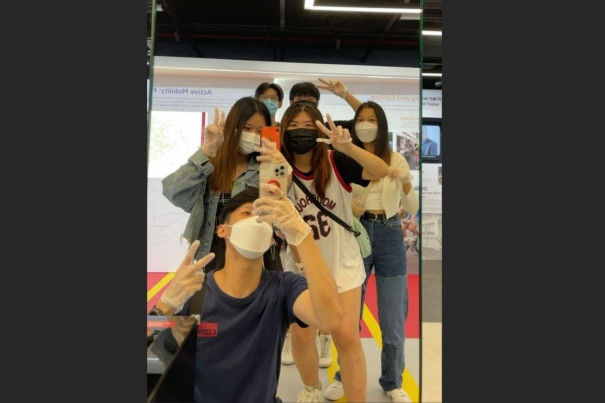
Brayden recalls how the team combed through a lot of information for their campaign. “Before we even started posting (on social media), we needed to familiarise ourselves with the rules and code of conduct,” he says.
Both teams tapped on online resources for inspiration, like Land Transport Authority and NParks websites, and offline ones, with visits to the Singapore Mobility gallery.
Inspired by Street Fighter

While the students found the information essential and useful, they also realised that part of the reason why they, like many of their peers, didn’t pay attention to the rules was because it could be a little too “heavy” to absorb. They realised that it would be better to break down the information into bite-sized messages, memes and videos.
“We had to figure out how to bring the message across without making it a super dry theoretical lesson,” says Jasmine Lim, 20.
Both teams decided to go with what youths are most comfortable with nowadays, and came up with a fun campaign using humour, freebies, and games.
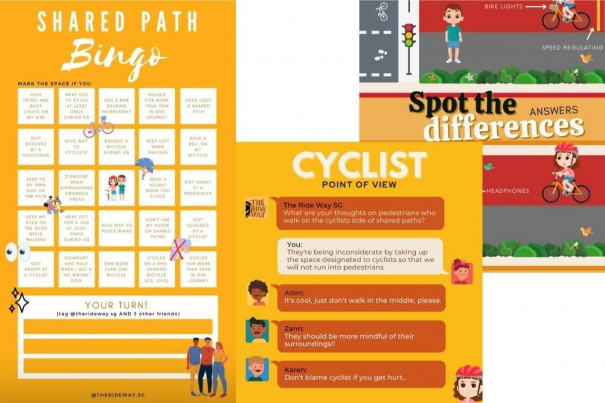
The Ride Way team went on Instagram with games like spot-the-difference, bingo and word searches to convey information on path sharing. Mindful of the sometimes harsh opinions that can come from both pedestrians and cyclists, the team posted role-playing scenarios that spelled out concerns from both sides, so that users could see both sides of the argument.
In fact, the team took this “rivalry” between pedestrians and cyclists to the next level, by creating a tongue-in-cheek video that was inspired by the Street Fighter computer game.
Source: Youtube / Singapore Kindness Movement
In the video, we see a cyclist and pedestrian on a collision course on a shared path, both refusing to give way. When the inevitable happens, the video turns into a stylised 1v1 combat scene a la Street Fighter and the two combatants fling insults at each other like kungfu kicks and punches.
Of course, it doesn’t end in real violence, as we are then introduced to Ollie, the pedestrian hero and Wheelie, the cyclist hero, who swoop in to end the argument and share safety tips for both the pedestrian and cyclist, who learn the errors of their ways.
The team wanted to use humour to defuse any arguments while showing both sides of the story.
“Throughout our campaign, we also wanted to show the issue through both lenses,” says Aldric Lee, 19.
“We want cyclists and pedestrians to understand each other’s perspective, and work around their ego,” adds Shayne Tan, 19.
Making the right choices in 8-bit sprites
The team behind the More Than Ride campaign went with popular Tiktok video formats.
Says Joyce: “We tapped on trending content to suit our campaign, like those ‘tell me without telling me’ and ‘this or that’ videos you see on Tiktok.”
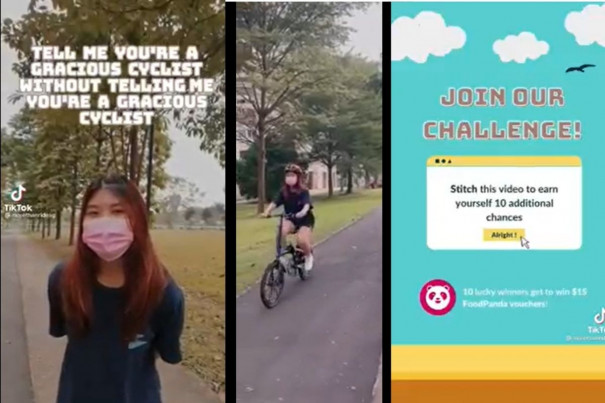
More Than Ride also launched social media challenges that invited the public to share their views and gracious habits, in return for a chance to win prizes like food delivery vouchers.
The campaign generated a momentum on its own, as some of its supporters began asking for posts with more information for both pedestrians and cyclists.
“We put up posts about the Active Mobility Act called ‘Fact or cap’ (True or False). We also explain theory test tips, and hand signals through our mascots, for example,” Joyce says.
When the campaigns were still active, the teams had more than 900 followers on Instagram and Tiktok. As the campaigns have ended, both teams have deactivated the social media accounts they set up for the purpose.
The biggest draw of their campaign however was More Than Ride’s video presentation, which was modelled after 8-bit video games where the user has to make choices to move the adventure forward.
The game, an interactive story that teaches path-sharing rules, features a cyclist named Rolly and a fairy named Cora. The team reveals that Cora’s name came from the term “co-sharing”, and both Rolly and Cora’s appearances were modelled after Japanese-style RPG sprites.
The video starts with Rolly, a careless cyclist, who falls off his bicycle while cycling because he was using his phone. He wakes up in an 8-bit game world, where he meets Cora. To get back to the real world, Rolly finds out that he has to make three correct choices in the game.
Each video of the four-part series features a path-sharing situation, where Rolly has to pick between two choices: for example, should he ride on the shorter pedestrian path if there was no one there? Or, when encountering pedestrians who refuse to give way, should he dismount or ride through slowly?
Pledging to ride safer
Aside from educating the public on shared paths in a fun way, both teams also invited social media users to pledge themselves to learning more about being gracious on the paths.
“We need a proactive culture where youths will educate themselves on potential hazards, and keep a lookout for important changes to things like the Active Mobility Act,” says Darren Chan, 19.
It is also important to encourage those who hear the message to keep spreading the word to their own friends and family.

Both teams collected more than 250 pledges on social media, with about 120 supporters passing on the message to their own social circles.
Apart from pedestrians, the students also received gratitude from cycling communities on Instagram, who appreciated the effort made to raise awareness about path sharing.
Throughout their campaigns, the students were constantly making tweaks to the messages according to public feedback and news stories.
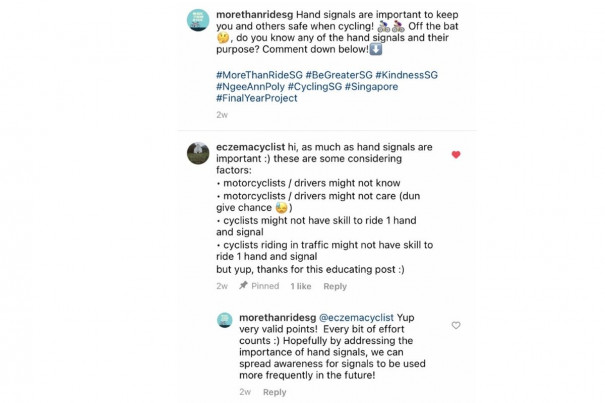
Impacting others and themselves
Having seen the campaign from start to finish, the students themselves grew to understand the importance of empathy and being able to see the other side’s point of view when it comes to using shared paths.
“As a pedestrian, I usually give way to food delivery riders most of the time already, but it can still get annoying. Now that I’ve begun to understand things more from their point of view, I’m more empathetic and try to give way as much as possible,” says Aldric.
Most importantly, the students shared that they realised that being in public meant that they needed to consider the outcomes of their actions. Simple actions, good or bad, may affect others without your knowledge, and the rules exist for everyone’s safety.
“Following the rules is an act of graciousness,” says Brayden.
“Besides raising awareness (on shared paths), we hope to inculcate graciousness in Singaporeans, to encourage them to be the better person,” Aldric says. “You are the greater person for giving way, compared to when someone gives way to you.”
The project didn’t just change their lives, though, the students found that their campaign had also left a lasting impact on their peers.
“Now when I’m out with my friends, they would remind me to walk on the left,” says Joyce with a laugh.
If you like what you read, follow us on Twitter and Google News to get the latest updates.
